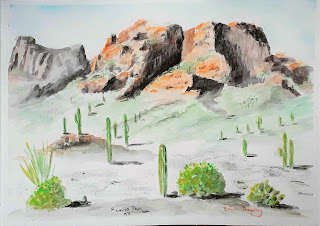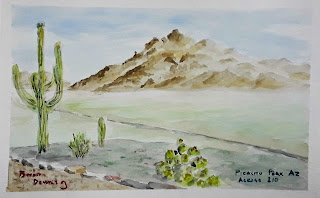We bumped
into one of the Photo Club Members during the Casa Grande Art
Associations annual “Studio Tour” and he asked if I was
interested in going on a Jeep ride out to an old abandoned mine. I was
in like a flash and had a great time. Thanks Darren.
Every
year the winter suddenly ends when we realize it's going to be a
couple of weeks until we move on again. This winter is no exception
and the “3 weeks to go” panic is upon us!
The
big project has been to get our “New to Us” car (a Mazda MX-5
which everyone in the US calls a Miata even though Mazda has dropped
that name).
| New to us Mazda MX-5 |
When
you want to tow a car “Flat” or “4 down” you have to make
some modifications to it. Flat or 4 down means that it sits on it's
own 2 wheels and you pull it behind your motorhome. You have to
ensure that it can be towed that way, FMCA publish a list of what
vehicles can be towed by model year, and under what conditions. Some
need the battery disconnected. Others have to be towed on a “dolly”.
Some can only be towed if they are completely off the road on a
trailer.
See previous post
https://banbrv.blogspot.com/2014/11/the-little-flat-green-thing-in-road.html
See previous post
https://banbrv.blogspot.com/2014/11/the-little-flat-green-thing-in-road.html
The
particular model of MX-5 we have is supposed to be one that CANNOT be
flat towed per Mazda. I have however been talking with a gentleman
who has been towing his for 6 years and 50,000 miles without any
damage, and he knows several other people who also tow them.
This
of course is AT OUR OWN RISK. If we break it we will have to
pay to fix it. This may see crazy but there are several other
vehicles listed as not towable by the manufacturer but actually can
be. Stick shift Mini's come to mind, and we've met several people who
have towed them many 10's of thousand miles without problems.
So
I'm taking a chance.
We
bought a used tow bar for the motorhome last winter in Alabama and it
came with the majority of the parts needed for the car too. I was
almost going to tell the seller to keep the car side of it as it was
a different make than we had on the Fiesta, but she didn't want it
and I threw it in the storage area and forgot about it.
The
first thing we needed was some way of attaching the car to the tow
bar on the motorhome.
The
Fiesta was fitted with a Blue Ox system, which is quick, light, easy
to use and secure.
There
are a few manufacturers of towing systems, the biggest I think being Blue Ox
and Roadmaster. The motorhome originally came with a Roadmaster
towbar and the company who set the Fiesta up changed out the end
fittings to Blue Ox ones to suit the car. We've been very happy with
the Blue Ox setup.
We
found that only Roadmaster sold a tow bracket for this model MX-5,
which unfortunately we couldn't get Blue Ox adapters for, so we were
stuck with the somewhat clunky Roadmaster connectors.
I
ordered the bracket and a wiring adapter kit from Etrailer.com and
they shipped them free and FAST!
I
considered trying to fit it myself as the only mechanical change was
drilling out 4 existing holes to 1/2” diameter. The problems were
that the campground doesn't allow car repairs on site, and the work
requires removing and replacing the whole nose of the car to get at
the area the bracket mounts to.
I
decided to leave the work to Whitaker Auto around the corner from the
park, who did great work on the motorhome this winter.
The
parts I bought from Etrailer where just the parts on the car.
Roadmaster's system requires a series of plates, bars and pins on the
outside of the car to provide the link to the tow bar on the
motorhome. We were so lucky, the parts we bought in Alabama and
didn't want back then fitted right on the MX-5. All we needed was a
pin that cost $20.
Modern
cars are full of computers. Those computers can be damaged by stray
voltages and connecting directly to the existing brake, turn and
running lights creates those stray voltages. The answer is and
electrical device called a diode which lets electricity flow in 1
direction only. The wiring kit came with special diode setups which
allow the brake lights on the car to function as both brake and turn
signal lights and the running lights to come on with the motorhome
lights when towed. When not plugged in to the motorhome they function
as designed.
That
basically is the whole setup.
Now
knowledgeable RV'ers will yell “Foul! You need a braking system for
the car”.
There
is a problem. The law requires trailers over a set weight to be
equipped with a braking system with a “Break away” feature to
stop the trailer in case it gets detached from the tow vehicle. A car
isn't a trailer. If you tow a car behind another car, you aren't
obliged to link the braking system of the 2 vehicles. That's the
problem, and there is a LOT of discussion about it. We fitted the
Fiesta with such a system at great cost.
In Canada a couple of years ago (thru my own fault), I towed the car with the brakes partially on and did $4000 damage.
https://banbrv.blogspot.com/2016/08/prince-edward-island-and-car-trouble.html
We've never used it since and never found a need for it.
In Canada a couple of years ago (thru my own fault), I towed the car with the brakes partially on and did $4000 damage.
https://banbrv.blogspot.com/2016/08/prince-edward-island-and-car-trouble.html
We've never used it since and never found a need for it.
So,
I decided not to fit the brake system at this time.
Scott
and Suzanne who we've known since our first Escapees Rally and just
before we all went full time, sent us a message that they were going
to be near Phoenix on their way west. A few phone calls and we were
all sitting around in the Elks Lodge followed by dinner out. It was
so good hearing about their adventures and sharing ours.
Somehow
the Art scene has burst wide open in the final 2 weeks here. Tuesdays
is the Inter Community Art and Craft group, Wednesday is Life
Drawing, Thursday the Sundance RV art group, now I have discovered a
“Plein Air” painting group who go to different venues on
Saturdays and paints outdoors! The rest of the week I have to draw
and paint on my own!
 |
| Picacho Peak |
 |
| Across the valley |
All
this bodes well for next year as I should be able to pick up where I
left off and get stuck straight in.
| Works in Progress!! |



